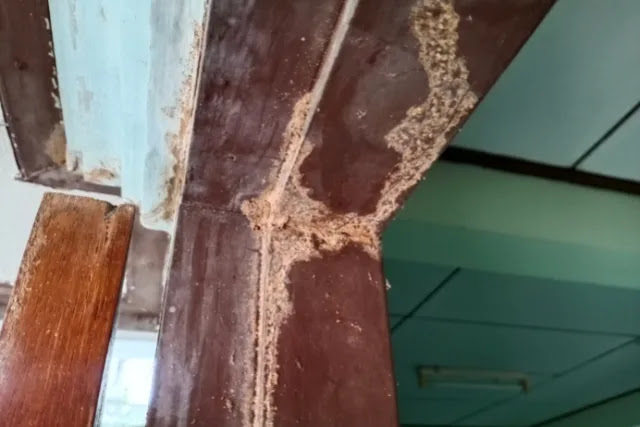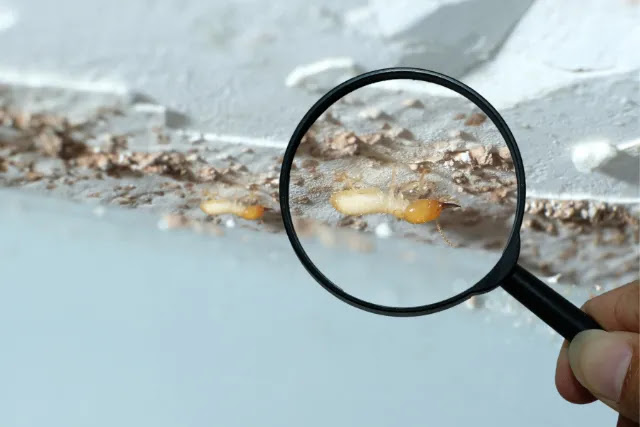Home and business owners unanimously agree that termites are the most destructive pests. These aggressive little creatures are known for causing structural damages worth millions of dollars per year.
Like ants, termites are social insects. This means they attack in thousands or even millions of numbers, with a mature colony containing between 50,000 and 2,000,000 workers! Yes, you've read that right.
Unfortunately, termites are pretty challenging to control. That's primarily because they are pros at hiding, eating away at your structures from the inside out. In fact, most property owners do not realize they have been infested until after there are visible signs of a termite infestation, such as drooping drywall, peeling paint, and hollowed wood.
Given the expensive damages caused by these destructive pests, it's understandable for you to wonder, 'do termites come back after treatment?' The short answer is yes; they can.
{tocify} $title={Table of Contents}
First, Why Do Termites Invade Homes? What are Termites Attracted to?
Termites find our homes quite appetizing, but why is that? There are several things that make our homes vulnerable to termite infestations. But for the most part, these destructive little devils will come into your home in search of food, moisture, and warmth.
A termite menu primarily consists of cellulose, which is obtained from wood and by-products (wood pulp) of trees, such as paper and cardboard. That's why our homes and businesses are prime locations for termites.
In particular, termites prefer eating rotting or malleable wood, especially one that is already softened by moisture or decay. So, if there are wood piles inside or near your home, these pesky pests will eventually attack.
Once inside your home, termites can spread rapidly, with the queen laying up to 30,000 eggs daily! This results in thousands of termites spreading throughout the wooden structures in your home. Unless controlled fast and effectively, a termite infestation can cause extensive damage and severely compromise the structural integrity of your home or business.
So, How Do Termites Get in Your Home?
Understanding why and how termites enter your home is crucial when preventing or eradicating an infestation. There are many ways a hungry termite colony can get into your home or business. Generally, varying termite species will get into your home in different ways.
For instance, subterranean termites, which live underground, typically enter homes at ground level or through items that have wood-to-ground contacts, such as doorframes, supports, porch steps, and deck posts. They can also exploit the cracks in your foundation or holes in concrete blocks to enter your home. When controlling subterranean termites, pest control experts focus on addressing problem areas like moisture issues around the foundation.
On the other hand, drywood termites can enter your home on any floor, regardless of whether or not it has wood-to-ground contact. They also invade homes through cracks and crevices in the walls or foundation. Because they can enter your home or business at any level, drywood termites are more difficult to control. Pest control experts recommend proactive measures such as maintaining your home's exterior and interior wood in good condition and pre-construction termite treatment.
Are Termite Treatments Effective? Do They Ever Fail?
There are multiple types of termite treatments, from fumigation and baiting to liquid chemicals. Each of these treatments has varying degrees of effectiveness in exterminating termites.
Generally, these treatment methods provide effective termite control results when administered by a professional pest controller. Depending on the nature and level of the infestation, the expert may offer regular inspections and treatments to ensure successful control and prevent the risk of future infestations.
But do termite treatments ever fail? There is no guarantee that even the most effective termite treatment option will rid your home entirely of termites. That’s why you are advised to strictly engage a highly trained and experienced pest control company. These companies offer customized treatment plans that ensure total termite extermination. They also create a highly effective termite protection barrier around the perimeter of your property.
Why Do Termites Come Back After Treatment?
Termites are one of the most challenging pests to control. That's primarily because they live in the soil or wood and reproduce rapidly. Depending on how the initial treatment was done, termites can come back after treatment.
Here are the five common reasons termites come back after treatment:
Nature of the First Termite Treatment
One of the most common reasons termites come back after treatment is if the initial treatment is incomplete or ineffective. There are multiple termite species, each requiring a unique treatment method for complete extermination. Misidentifying the termite species on your property leads to applying the wrong treatment, and the results may not be 100% effective.
Additionally, termites reproduce rapidly. This means that even if one or two termites are missed during the treatment, they will reproduce and form a new termite colony in a few weeks. That's why it is vital to engage a company with a good reputation for highly effective and thorough pest control services.
There's Still Wood in or Around Your Home That's Touching the Ground
Termites are resilient pests and have a habit of returning after treatment. That is especially true if there is still wood in or around your house touching the ground.
When administered by a professional, termite treatments such as fumigation provide extremely effective drywood termite control results. However, subterranean termites live in the soil underground. They come to the surface in search of cellulose, which is mainly obtained from wood.
If there is still wood resting on the ground, subterranean termites will exploit it as a food source and a highway into your home/office.
High Moisture Content in Your Home
Termites are highly attracted to moisture. They need moisture, food, and warmth to survive. So, if your home has high moisture content and or high humidity levels, you can expect a termite re-infestation soon.
Dampwood termites and subterranean termites typically thrive in soft, damp wood. Issues such as leaky pipes, faulty faucets, and poor water drainage increase dampness in your property, putting it at a greater risk of termite re-infestations.
The Geographical Location of Your Home
Unfortunately, no type of termite treatment offers a permanent solution for termite extermination in your home. That means that if the conditions in your geographical location are favorable, there is a high chance that termites can come back after treatment. People living in areas with warm and humid climates are naturally at a higher risk of repeat termite infestations.
There is Mulch Close to Your Home's Foundation
Mulch is a source of food for termite colonies. These destructive pests also make their nests beneath the mulch layer.
Mulch can attract termites to your yard. And if the mulch has made direct contact with your home's foundation, you can expect the termites to find a way into your home within a few days.
Use These Tricks to Keep Termites Away After Treatment
- Keep mulch a good distance (at least one foot) from your home's foundation. Even better, use hardwood mulch which repels termites instead of attracting them as softwood mulch does.
- Remove any wood in and around your property that's touching the ground. This is a good way of stopping subterranean termites from using wood as a bridge to sneak into your home.
- Ensure all firewood is kept away from your home. On top of that, ensure the firewood is placed on a raised area or on a cemented foundation to keep subterranean termites away.
- Reduce the moisture content in your home using a dehumidifier. You should also fix leaky pipes and faulty faucets to reduce dampness in your home. Additionally, you should address any waterlogging issues in your yard and basement and ensure the soil around your home's foundation is dry.
- Engage a pest control company that provides a warranty after termite treatment. Although termite treatment services with warranties are relatively more expensive than those without, they give you peace of mind knowing that the exterminator will regularly visit your home to ensure it's not at the risk of another infestation.
What Are the Signs of a Termite Infestation in Your Home?
It's crucial for home and office owners to understand the early signs of a termite infestation, such as damaged under paint/wallpaper and swarmers/swarmer wings.
Being able to detect a termite problem helps you address the issue before it gets out of hand, saving you thousands of dollars in repair and treatment costs.
Here are the early signs of a termite infestation that you should be on the lookout for:
Cracked Paint or Peeling Wallpaper
Bubbling paint and damaged wallpaper can be a telltale signs of termite activity. Termites are notorious for creating tunnels (galleries) and tiny holes (exit holes) on wooden structures. This type of damage can be difficult to detect early. That's because termites can live in wall voids for many years without disturbing the thin layer of paint or wallpaper on the surface. Often, termites in walls are discovered during renovations or repairs when the wallpaper/paint is removed.
Look out for the following signs of termite damage when inspecting your walls:
- An unusual appearance of paint (bubbling paint)
- Discoloured wallpaper
- Small pin holes (termite exit points)
- Surfaces on the wall that seem sunken or dented
- Bentwood
Mud Tubes
Mud tubes are one of the most obvious signs of a termite infestation. Just like subway tunnels, subterranean termites build mud tubes for transportation. These tubes connect their underground nests to the above-ground food source (exposed wood).
Also known as galleries or tunnels, mud tubes are made from soil, wood, and termite saliva. These tubes also offer protection from predators and dry air. While you can find mud tubes on any wooden structures, they are most prevalent in your home's foundation and outside walls.
You can break the mud tubes to confirm if there's an active termite infestation. Even if termite activity may seem dormant at the time, you should engage a termite control expert to inspect and treat your home.
Termite Swarmers and Discarded Wings
If you notice termite swarmers or discarded wings, you should be concerned. Also known as alates, termite swarmers are the reproductive members of a termite colony. They have a pair of white or translucent wings that they shed once they have found a suitable mate and a perfect place to establish a new colony.
Swarmers are typically attracted to light; hence, you'll often find them near doors and windows. However, most of these flying termites don't survive long enough to form a colony – you can find dead swarmers and discarded wings near entryways and windowsills. Termite swarmers and discarded wings should have you calling a pest control expert immediately.
Also read :




